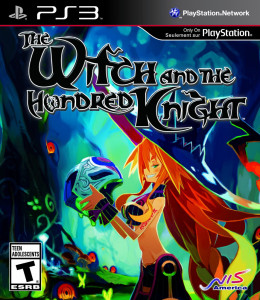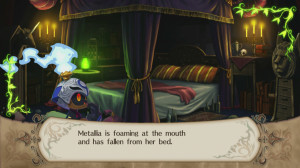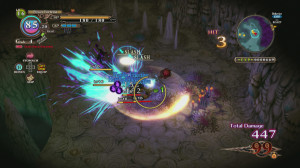NIS has a long history of producing games from the villains perspective with their Disgaea franchise, but they take it to a whole new level with the titular witch of this PlayStation 3 game. While Laharl does have some redeeming qualities, such as the care he has for his minions which he attempts to hide, Metallia has none to speak of. The foul-mouthed witch desires nothing more than to spread the swamp in which she lives across the world. Because she will not tread anywhere the swamp has not already claimed, she summons the legendary Hundred Knight to enforce her will outside of the territory she controls by unlocking or ‘blooming’ pillars that will seed new areas of swamp.
The player jumps in as the Hundred Knight begins to gain consciousness. Starting with little more intelligence than the average store mannequin, the Hundred Knight gains intellect over the course of a brief tutorial as Metallia attempts to bring him into the real world. This introduces the player to the controls, before thrusting them into their fist mission where the games many features come into play. First and foremost of these is the gigacals that limit the amount of time the knight can spend away from his master. To think of these like calories from food would not be far wrong, in fact, the Hundred Knight can even consume his enemies to replenish some GCals! Also like calories, these are spent performing every action in the field, from walking around, fighting, or simply replenishing health. While at first this seems like it will severely limit the amount of time one can spend in the field before returning home, there are ways regain GCals.
Another system at work in the field are grade points. These are gained by killing enemies and can be spent at any unlocked pillar, offering temporary stat boosts, restoring GCals to the Hundred Knight, or increasing the amount of bonus points the player has accumulated since leaving home. Bonus points are part of a mechanic that shows a great deal of influence from Disgaea. Every time the player enters a field map, a random assortment of loot is assigned to ten different tiers. Bonus points are also earned by killing enemies, and as the player accumulates these points, they start unlocking reward tiers. If a player voluntarily returns home, they lose all grade points, temporary stats gained from spending grade points and any bonus points they have accumulated. However, they do get to keep any items picked up in the field as well as any rewards they have unlocked.
Any items that are collected in the field are ‘eaten’ by the Hundred Knight. That is to say, they are stored in his stomach until he returns home. Should he die, the contents of his stomach is lost forever. This mechanic means that any items carried into the field maps are safe, while any items found are at risk should the player die. The capacity of the stomach is limited, but can be expanded by exploring field maps for black chests that may contain unique items that benefit the Hundred Knight on his quest, including Tochkas, magical beings that the knight can summon to aid him in clearing obstacles in his path.
Outside of boss battles combat can get a little stale. Enemies are usually downed in a few hits by mashing the attack button, unless they have resistances to certain weapon types, but the real magic of combat comes from setting up the knight’s gear. The Hundred Knight can equip up to five weapons at a time, each forming part of a combo as the knight attack his enemies. There are five weapon types in the game, each having a unique style of attack. Each weapon is unique as well, as they come in a variety of rarities that affect how much a weapon can be levelled up, and what part of the chain that should be in. Each weapon has between one and five dots. Putting a two dot weapon after a one dot will increase the attack rate of the combo. A one dot can be placed after a five dot should the player wish to alter the order of the weapons used.
The graphics of The Witch and the Hundred Knight are very much like those of Disgaea, only the characters are in 3D as they move around field maps. Conversation between characters usually involve 2D art representing the important characters in the game, again, very much like Disgaea. Once the Hundred Knight dive into combat, the screen can look a little cluttered with weapons and magic flying everywhere, but this is not much of an issue as long as the player keeps an eye on the knights health. The scenery can sometimes obscure the players view of the environment, but enemy health bars are always visible, so there is not chance of being ambushed by unseen assailants.
The soundtrack to the game is quite catchy and has a number of quality tracks, but yet again, is very similar to Disgaea. Most conversations are voice acted, and while Metallia’s worst expletives are censored, it is obvious what they were from listening to the conversation. It is also easy to understand that Metallia is angry at the world and dislikes everyone else in it, even her subordinates, who she barely seems to tolerate.
The Witch and the Hundred Knight is a worthwhile purchase for fans of NIS America games. The many features of the game may seem confusing from the outside, but are simple to understand once the game is underway. Potential buyers should be aware that Metallia’s use of bad language is frequent enough to put some people off the game, and is far more insulting than that found in any other NISA games. This game takes a little over twenty hours to complete if one rushes through it, but will take a fair bit longer is each map is revisited for maximum exploration.


